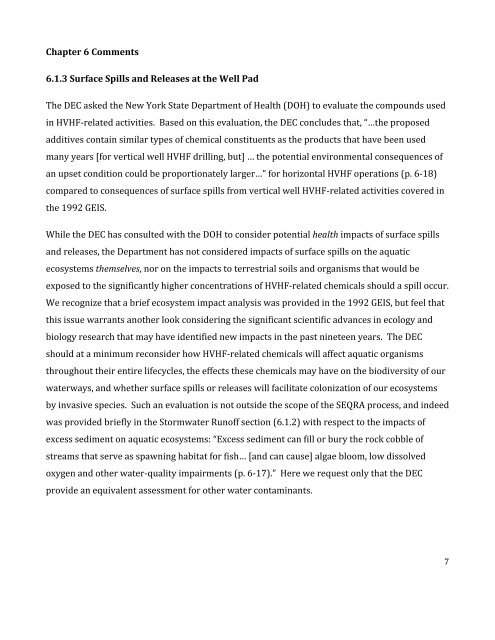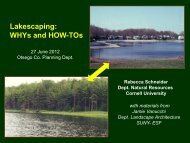file. - Otsego County Conservation Association
file. - Otsego County Conservation Association
file. - Otsego County Conservation Association
Create successful ePaper yourself
Turn your PDF publications into a flip-book with our unique Google optimized e-Paper software.
Chapter 6 Comments<br />
6.1.3 Surface Spills and Releases at the Well Pad<br />
The DEC asked the New York State Department of Health (DOH) to evaluate the compounds used<br />
in HVHF-related activities. Based on this evaluation, the DEC concludes that, “…the proposed<br />
additives contain similar types of chemical constituents as the products that have been used<br />
many years [for vertical well HVHF drilling, but] … the potential environmental consequences of<br />
an upset condition could be proportionately larger…” for horizontal HVHF operations (p. 6-18)<br />
compared to consequences of surface spills from vertical well HVHF-related activities covered in<br />
the 1992 GEIS.<br />
While the DEC has consulted with the DOH to consider potential health impacts of surface spills<br />
and releases, the Department has not considered impacts of surface spills on the aquatic<br />
ecosystems themselves, nor on the impacts to terrestrial soils and organisms that would be<br />
exposed to the significantly higher concentrations of HVHF-related chemicals should a spill occur.<br />
We recognize that a brief ecosystem impact analysis was provided in the 1992 GEIS, but feel that<br />
this issue warrants another look considering the significant scientific advances in ecology and<br />
biology research that may have identified new impacts in the past nineteen years. The DEC<br />
should at a minimum reconsider how HVHF-related chemicals will affect aquatic organisms<br />
throughout their entire lifecycles, the effects these chemicals may have on the biodiversity of our<br />
waterways, and whether surface spills or releases will facilitate colonization of our ecosystems<br />
by invasive species. Such an evaluation is not outside the scope of the SEQRA process, and indeed<br />
was provided briefly in the Stormwater Runoff section (6.1.2) with respect to the impacts of<br />
excess sediment on aquatic ecosystems: “Excess sediment can fill or bury the rock cobble of<br />
streams that serve as spawning habitat for fish… [and can cause] algae bloom, low dissolved<br />
oxygen and other water-quality impairments (p. 6-17).” Here we request only that the DEC<br />
provide an equivalent assessment for other water contaminants.<br />
7




